The Rise of Reclaimed Wood
If you watch a lot of HGTV like I do, you’ll know that reclaimed wood seems to be having a moment. I’m always amazed at the talented folks like Ben Napier on Home Town who can whip up a gorgeous kitchen island from the remains of a drooping front porch. But we don’t need to travel to Laurel, Mississippi to find artisans who are skilled at giving vintage wood new life. We’ve got our own talented professionals right here in New Jersey.
We were thrilled to get a chance to discuss the resurgence of reclaimed wood with Anthony Saraceno, General Manager and Master Carpenter at Real Antique Wood in Irvington. He has lots of experience transforming timeworn planks into treasured pieces. That’s him, below. (He didn’t stop working long enough to get a shot of his whole face.)
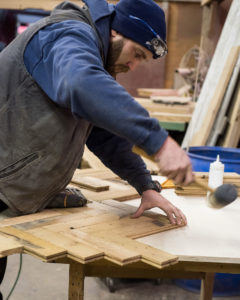
All photos courtesy of Real Antique Wood
In fact, we were lucky to get that one, since a lot of the time he looks like this:
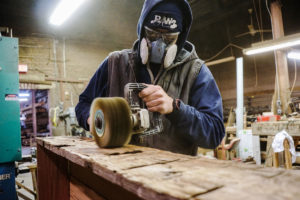
That’s a wire brush. It removes paint or finish from the wood.
We asked Saraceno to explain why reclaimed wood is a good choice for your home. Here’s what he said:
1. Because Sustainable Is Sensible
“Everybody’s trying to go green with sustainable resources,” Saraceno points out. Certainly, we can all get on board with saving a tree or two by working with wood that’s already been harvested. But Saraceno and his team go even farther; they refuse to waste even decayed-beyond-repair wood. “Every once in a while we come across pieces that are too far gone for us,” he notes. “So we have a guy who picks up all of our wood scraps and uses them for mulch for his landscaping company.” But even that’s not enough for Saraceno, who takes micro-recycling to the next level: “We have another guy who picks up all our sawdust and uses it for horse bedding.”
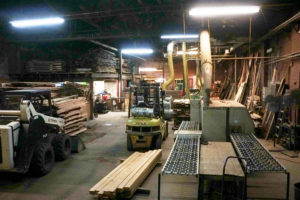
Look, no sawdust! It’s all been neatly swept up for re-use.
2. Because Antique Doesn’t Mean Antiquated
Salvaging techniques perk up worn wood pieces, removing unwanted remnants of years of use, leaving the beauty of raw wood . Though the procedure varies depending on “what the product is destined to be at the end of the day,” the process Saraceno describes is fascinating. “First, the material will come in and it will be de-nailed. We’ll use a metal detector, not unlike the ones they use at the Port Authority. Everything we find in the beams—staples, nails, etc.—we remove.”
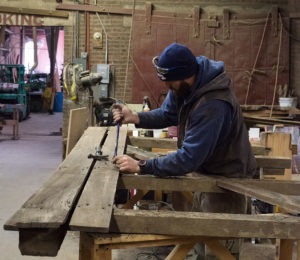
It takes a deft touch to remove nails like these that date to the 18th century.
Next, pests must be banished. Saraceno says that “powderpost beetles are very common” in vintage wood. But, “there are also hundreds of other types of wood-consuming insects we find, including carpenter bees and ambrosia beetles. It’s also not uncommon to find other insects such as spiders and centipedes hiding in nooks.”
Okay, I may have freaked out a little when he said this; but I felt a bit calmer when he explained: “The kiln ensures that those insects are not getting passed on to the owner of the material.” (For the record, though, this still marks the end of my dream of becoming a reclaimed woodworker.)
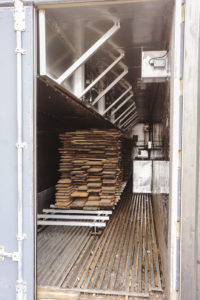
It’s not a cargo container; it’s a kiln. It lowers the moisture content and sterilizes the wood: newer wood pieces are placed between the vintage planks to keep air circulating.
Once it’s been de-bugged, the wood gets sized according to its intended use.
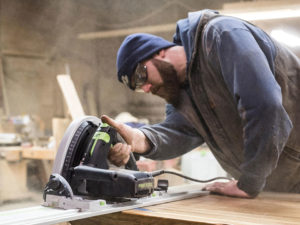
This piece of wood is on its way to being a desk. (That’s a track saw.)
And remember those nails that were removed? Like just about everything else in the mill, they’re recycled. “Most of the time we’ll actually put the nails back into the wood once the project is complete, but more as a decorative accent. When we reuse nails, we don’t rely on them to hold a piece together.”
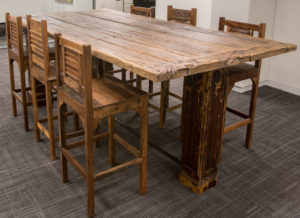
3. Because Classic Is Cool
There’s something deeply gratifying about including antique re-purposed wood in home décor; it makes you feel like a part of history. Saraceno describes the oldest piece of wood he’s used in a project. “It was from a house in River Vale that was built in 1747—the William Holdrum house. Some paperwork indicates the construction was started in the 1730s.” After the house was dismantled, it went to auction. Saraceno and his team, always on the lookout for prime vintage pieces, purchased it. They found the perfect project to resurrect it when they worked on a “historic restoration/renovation on a house that dated to 1760. The material was re-milled and used for the flooring. Some of the larger timbers were used for decorative ceiling beams. “
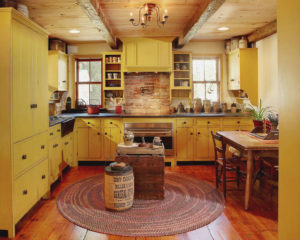
If these beams could talk…..
4. Because Vintage Is Versatile
If you’re looking for flooring that shows vintage charm, Saraceno says “soft wood, such as pine or hemlock shows character, texture and patina. It takes a little bit of a beating. The dents and dings just add to the character of the wood.”
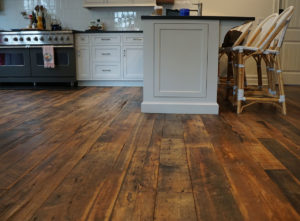
Saraceno calls this pine and hemlock flooring “Old Pub.”
For a look with a little less “character,” choose a wood type such as hickory or white oak. “Hickory or white oak can be used for just about anything,” says Saraceno. “This would be our recommendation for home (or commercial) flooring with pets and heavy foot traffic. It’s much more dense and wear resistant.”
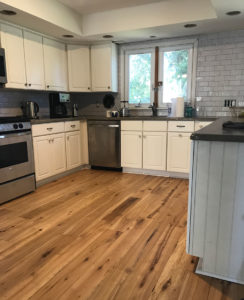
Hickory flooring is more wear resistant.
I just love the thought of re-using pieces that were used by generations before, to literally reclaim a part of the past. As Saraceno says, “It’s a beautiful thing to give the wood a second life, but being able to pass along American history through our work is a true privilege.”
